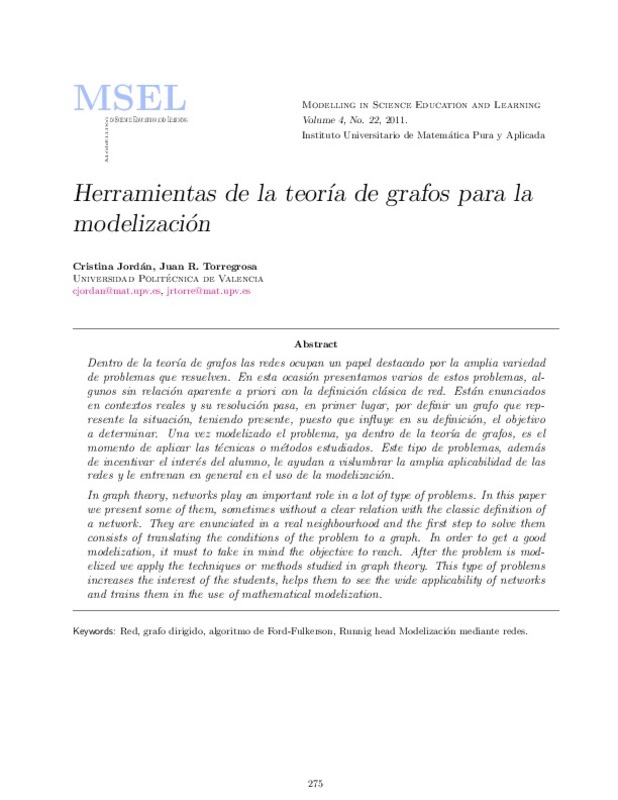JavaScript is disabled for your browser. Some features of this site may not work without it.
Buscar en RiuNet
Listar
Mi cuenta
Estadísticas
Ayuda RiuNet
Admin. UPV
Herramientas de la teoría de grafos para la modelización
Mostrar el registro sencillo del ítem
Ficheros en el ítem
| dc.contributor.author | Jordan, Cristina
|
es_ES |
| dc.contributor.author | Torregrosa, Juan R.
|
es_ES |
| dc.date.accessioned | 2018-04-24T10:47:47Z | |
| dc.date.available | 2018-04-24T10:47:47Z | |
| dc.date.issued | 2011-06-05 | |
| dc.identifier.uri | http://hdl.handle.net/10251/100938 | |
| dc.description.abstract | [EN] In graph theory, networks play an important role in a lot of type of problems. In this paper we present some of them, sometimes without a clear relation with the classic definition of a network. They are enunciated in a real neighbourhood and the first step to solve them consists of translating the conditions of the problem to a graph. In order to get a good modelization, it must to take in mind the objective to reach. After the problem is modelized we apply the techniques or methods studied in graph theory. This type of problems increases the interest of the students, helps them to see the wide applicability of networks and trains them in the use of mathematical modelization. | es_ES |
| dc.description.abstract | [ES] Dentro de la teoría de grafos las redes ocupan un papel destacado por la amplia variedad de problemas que resuelven. En esta ocasión presentamos varios de estos problemas, algunos sin relación aparente a priori con la definición clásica de red. Están enunciados en contextos reales y su resolución pasa, en primer lugar, por definir un grafo que represente la situación, teniendo presente, puesto que influye en su definición, el objetivo a determinar. Una vez modelizado el problema, ya dentro de la teoría de grafos, es el momento de aplicar las técnicas o métodos estudiados. Este tipo de problemas, además de incentivar el interés del alumno, le ayudan a vislumbrar la amplia aplicabilidad de las redes y le entrenan en general en el uso de la modelización. | es_ES |
| dc.language | Español | es_ES |
| dc.publisher | Universitat Politècnica de València | |
| dc.relation.ispartof | Modelling in Science Education and Learning | |
| dc.rights | Reconocimiento - No comercial (by-nc) | es_ES |
| dc.subject | Red | es_ES |
| dc.subject | Grafo dirigido | es_ES |
| dc.subject | Algoritmo de Ford-Fulkerson | es_ES |
| dc.subject | Runnig head Modelización mediante redes | es_ES |
| dc.title | Herramientas de la teoría de grafos para la modelización | es_ES |
| dc.type | Artículo | es_ES |
| dc.date.updated | 2018-04-23T11:51:04Z | |
| dc.identifier.doi | 10.4995/msel.2011.3088 | |
| dc.rights.accessRights | Abierto | es_ES |
| dc.description.bibliographicCitation | Jordan, C.; Torregrosa, JR. (2011). Herramientas de la teoría de grafos para la modelización. Modelling in Science Education and Learning. 4:275-287. https://doi.org/10.4995/msel.2011.3088 | es_ES |
| dc.description.accrualMethod | SWORD | es_ES |
| dc.relation.publisherversion | https://doi.org/10.4995/msel.2011.3088 | es_ES |
| dc.description.upvformatpinicio | 275 | es_ES |
| dc.description.upvformatpfin | 287 | es_ES |
| dc.type.version | info:eu-repo/semantics/publishedVersion | es_ES |
| dc.description.volume | 4 | |
| dc.identifier.eissn | 1988-3145 | |
| dc.description.references | G. Chartrand, O.R. Oellerman, Applied and algorithmic graph theory, McGraw Hill 1993. A.Dolan, J.Aldous, Networks and algorithms, Wiley 1993. | es_ES |
| dc.description.references | J. L. Gross, J. Yellen, Graph theory and its applications, Chapman&Hall, 2006. | es_ES |
| dc.description.references | G. Hernández Pe-alver, Grafos. Teoría y algoritmos, UPM 2003. | es_ES |








